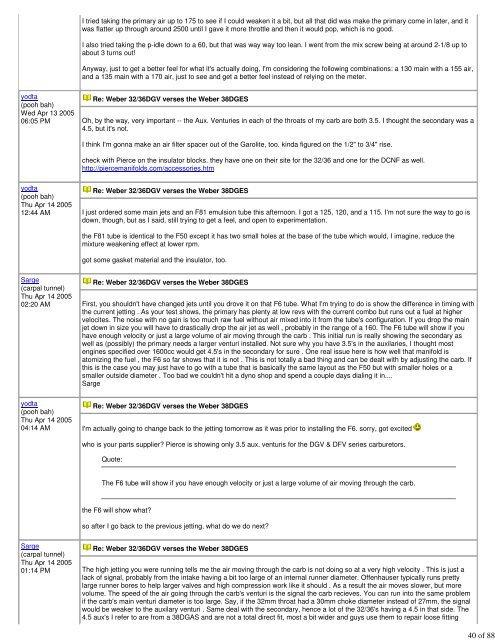Create successful ePaper yourself
Turn your PDF publications into a flip-book with our unique Google optimized e-Paper software.
yodta<br />
(pooh bah)<br />
Wed Apr 13 2005<br />
06:05 PM<br />
yodta<br />
(pooh bah)<br />
Thu Apr 14 2005<br />
12:44 AM<br />
Sarge<br />
(carpal tunnel)<br />
Thu Apr 14 2005<br />
02:20 AM<br />
yodta<br />
(pooh bah)<br />
Thu Apr 14 2005<br />
04:14 AM<br />
Sarge<br />
(carpal tunnel)<br />
Thu Apr 14 2005<br />
01:14 PM<br />
I tried taking <strong>the</strong> primary air up to 175 to see if I could weaken it a bit, but all that did was make <strong>the</strong> primary come in later, and it<br />
was flatter up through around 2500 until I gave it more throttle and <strong>the</strong>n it would pop, which is no good.<br />
I also tried taking <strong>the</strong> p-idle down to a 60, but that was way way too lean. I went from <strong>the</strong> mix screw being at around 2-1/8 up to<br />
about 3 turns out!<br />
Anyway, just to get a better feel for what it's actually doing, I'm considering <strong>the</strong> following combinations: a 130 main with a 155 air,<br />
and a 135 main with a 170 air, just to see and get a better feel instead of relying on <strong>the</strong> meter.<br />
Re: <strong>Weber</strong> <strong>32</strong>/<strong>36DGV</strong> <strong>verses</strong> <strong>the</strong> <strong>Weber</strong> <strong>38DGES</strong><br />
Oh, by <strong>the</strong> way, very important -- <strong>the</strong> Aux. Venturies in each of <strong>the</strong> throats of my carb are both 3.5. I thought <strong>the</strong> secondary was a<br />
4.5, but it's not.<br />
I think I'm gonna make an air filter spacer out of <strong>the</strong> Garolite, too. kinda figured on <strong>the</strong> 1/2" to 3/4" rise.<br />
check with Pierce on <strong>the</strong> insulator blocks. <strong>the</strong>y have one on <strong>the</strong>ir site for <strong>the</strong> <strong>32</strong>/36 and one for <strong>the</strong> DCNF as well.<br />
http://piercemanifolds.com/accessories.htm<br />
Re: <strong>Weber</strong> <strong>32</strong>/<strong>36DGV</strong> <strong>verses</strong> <strong>the</strong> <strong>Weber</strong> <strong>38DGES</strong><br />
I just ordered some main jets and an F81 emulsion tube this afternoon. I got a 125, 120, and a 115. I'm not sure <strong>the</strong> way to go is<br />
down, though, but as I said, still trying to get a feel, and open to experimentation.<br />
<strong>the</strong> F81 tube is identical to <strong>the</strong> F50 except it has two small holes at <strong>the</strong> base of <strong>the</strong> tube which would, I imagine, reduce <strong>the</strong><br />
mixture weakening effect at lower rpm.<br />
got some gasket material and <strong>the</strong> insulator, too.<br />
Re: <strong>Weber</strong> <strong>32</strong>/<strong>36DGV</strong> <strong>verses</strong> <strong>the</strong> <strong>Weber</strong> <strong>38DGES</strong><br />
First, you shouldn't have changed jets until you drove it on that F6 tube. What I'm trying to do is show <strong>the</strong> difference in timing with<br />
<strong>the</strong> current jetting . As your test shows, <strong>the</strong> primary has plenty at low revs with <strong>the</strong> current combo but runs out a fuel at higher<br />
velocites. The noise with no gain is too much raw fuel without air mixed into it from <strong>the</strong> tube's configuration. If you drop <strong>the</strong> main<br />
jet down in size you will have to drastically drop <strong>the</strong> air jet as well , probably in <strong>the</strong> range of a 160. The F6 tube will show if you<br />
have enough velocity or just a large volume of air moving through <strong>the</strong> carb . This initial run is really showing <strong>the</strong> secondary as<br />
well as (possibly) <strong>the</strong> primary needs a larger venturi installed. Not sure why you have 3.5's in <strong>the</strong> auxilaries, I thought most<br />
engines specified over 1600cc would get 4.5's in <strong>the</strong> secondary for sure . One real issue here is how well that manifold is<br />
atomizing <strong>the</strong> fuel , <strong>the</strong> F6 so far shows that it is not . This is not totally a bad thing and can be dealt with by adjusting <strong>the</strong> carb. If<br />
this is <strong>the</strong> case you may just have to go with a tube that is basically <strong>the</strong> same layout as <strong>the</strong> F50 but with smaller holes or a<br />
smaller outside diameter . Too bad we couldn't hit a dyno shop and spend a couple days dialing it in....<br />
Sarge<br />
Re: <strong>Weber</strong> <strong>32</strong>/<strong>36DGV</strong> <strong>verses</strong> <strong>the</strong> <strong>Weber</strong> <strong>38DGES</strong><br />
I'm actually going to change back to <strong>the</strong> jetting tomorrow as it was prior to installing <strong>the</strong> F6. sorry, got excited<br />
who is your parts supplier? Pierce is showing only 3.5 aux. venturis for <strong>the</strong> DGV & DFV series carburetors.<br />
Quote:<br />
The F6 tube will show if you have enough velocity or just a large volume of air moving through <strong>the</strong> carb.<br />
<strong>the</strong> F6 will show what?<br />
so after I go back to <strong>the</strong> previous jetting, what do we do next?<br />
Re: <strong>Weber</strong> <strong>32</strong>/<strong>36DGV</strong> <strong>verses</strong> <strong>the</strong> <strong>Weber</strong> <strong>38DGES</strong><br />
The high jetting you were running tells me <strong>the</strong> air moving through <strong>the</strong> carb is not doing so at a very high velocity . This is just a<br />
lack of signal, probably from <strong>the</strong> intake having a bit too large of an internal runner diameter. Offenhauser typically runs pretty<br />
large runner bores to help larger valves and high compression work like it should . As a result <strong>the</strong> air moves slower, but more<br />
volume. The speed of <strong>the</strong> air going through <strong>the</strong> carb's venturi is <strong>the</strong> signal <strong>the</strong> carb recieves. You can run into <strong>the</strong> same problem<br />
if <strong>the</strong> carb's main venturi diameter is too large. Say, if <strong>the</strong> <strong>32</strong>mm throat had a 30mm choke diameter instead of 27mm, <strong>the</strong> signal<br />
would be weaker to <strong>the</strong> auxilary venturi . Same deal with <strong>the</strong> secondary, hence a lot of <strong>the</strong> <strong>32</strong>/36's having a 4.5 in that side. The<br />
4.5 aux's I refer to are from a 38DGAS and are not a total direct fit, most a bit wider and guys use <strong>the</strong>m to repair loose fitting<br />
40 of 88


